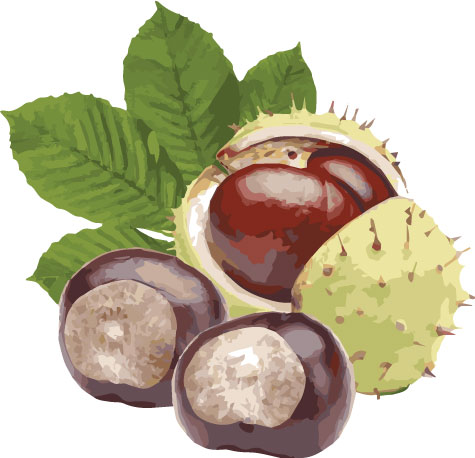Research on the influence of horse chestnut in cosmetics on our skin's immune system
Horse Chestnut (Aesculus hippocastanum)
Medicinal plant of the year 2008
In centuries-old monastic medicine, horse chestnut is considered one of the best remedies for blood vessels. It is traditionally used externally for blood vessel weaknesses and related conditions such as varicose veins, circulatory disorders, [1] bruising, [2]hemorrhoids [3],pain, swelling and heaviness in the legs [4],as well as abrasions, phlebitis [5], burns and frostbite[6] [7].
In China, horse chestnut is used for infections, inflammation, pain, and as an anti-aging remedy.[8]
Proven by numerous researches:
Horse chestnut preparations have a positive effect on hemorrhoids, edema formation[9], cellulitis, hematomas and water retention in tissues[10]. They also strengthen the immune system.[11].
Horse chestnut prevents thrombosis [12], provides support in breast cancer and prevents the formation of metastases[13].
Among 65 tested plant extracts, horse chestnut is among those with the strongest antioxidant and cell-protective effects[14].
Horse chestnut extract brings significant relief from chronic venous complaints such as muscle cramps, pain, fatigue, itching or tension in the legs[15] [16].
[1] Ašic, Simon, Pater Simons Hausapotheke: Handbuch zum Bestimmen und Sammeln von Heilpflanzen mit ausführlichen Rezepten, 2000
amazon
[2] Zhang, Z, Li, S, Lian, XY. An overview of genus Aesculus l.: ethnobotany, phytochemistry, and pharmacological activities. Pharm Crops 2010;1:24–51.
[Bentham Open]
[3] Newall, C.A., Anderson, L.A. and Phillipson, J.D. Herbal Medicines. A guide for health-care professionals. pp. 166–7, The Pharmaceutical Press, London (1996).
cabdirect
[4] Kedzierskia, B, Kocha, WK, Widelskia, J, Glowniak, K. Impact of harvest time of Aesculus hippocastanum seeds on the composition, antioxidant capacity and total phenolic content. Ind Crops Prod 2016;86:68–72.
[Science Direct]
[5] Srijayanta, S, Raman, A, Goodwin, BLA. Comparative study of the constituents of Aesculus hippocastanum and Aesculus indica. J Med. Food 1999;2:45–50. Journal of Medicinal FoodVol. 2, No. 2
[PubMed]
[6] Wilkinson, J. and Brown, A. (1999), Horse Chestnut – Aesculus Hippocastanum: Potential Applications in Cosmetic Skin-care Products. International Journal of Cosmetic Science, 21: 437-447.
pubmed pdf-fulltext
[7] Hagers, H, Hansel, R, Keller, K, Rimler, H, Schneider, G, Drogen, AD. Hagers Handbuch der Pharmazeutischen Praxis. Berlin: Springer-Verlag; 1992.
[Springer-Verlag Berlin Heidelberg]
[8] Patlolla, JMR, Rao, CV. Anti-inflammatory and anti-cancer properties of ß-escin, a triterpene saponin. J Curr Pharmacol Rep 2015;1:170–8.
[Springer]
[9] Aescin: pharmacology, pharmacokinetics and therapeutic profile, Pharmacological Research, Volume 44, Issue 3, 2001, Pages 183-193, ISSN 1043-6618,
sciencedirect
[10] Stajner, D, Popovic, BM, Calic, D, Stajner, M. Comparative study of antioxidant status in androgenic embryos of Aesculus hippocastanum and Aesculus flava. Sci World J 2014;11:1–8.
[Hindawi]
[11] Selvakumar, GP, Janakiraman, U, Essa, MM, Thenmozhi, AJ, Manivasagam, T. Escin attenuates behavioral impairments, oxidative stress and inflammation in a chronic MPTP/probenecid mouse model of Parkinson’s disease. Brain Res 2014;1585:23–36.
[Science Direct]
[12] Celep, AGS, Yilmaz, S, Coruh, N. Antioxidant capacity and cytotoxicity of Aesculus hippocastanum on breast cancer MCF-7 cells. J Food Drug Anal 2012;20:692–8.
[Spandidos Publications]
[13] Wang, Y, Xu, X, Zhao, P, Tong, B, Wei, Z, Dai, Y. Escin Ia suppresses the metastasis of triple-negative breast cancer by inhibiting epithelial-mesenchymal transition via down-regulating LOXL2 expression. Oncotarget 2016;7:23684–99.
[PubMed]
[14] Wilkinson, J. A., & Brown, A. M. G. (1999). Horse Chestnut–Aesculus Hippocastanum: Potential Applications in Cosmetic Skin-care Products. International journal of cosmetic science, 21(6), 437-447.
[PubMed] [Semantic Scholar full text]
[15] Marlena Dudek-Makuch, Elzbieta Studzinska-Sroka, Horse chestnut – efficacy and safety in chronic venous insufficiency: an overview, Revista Brasileira de Farmacognosia, Volume 25, Issue 5, 2015, Pages 533-541, ISSN 0102-695X
sciencedirect

 Deutsch
Deutsch 